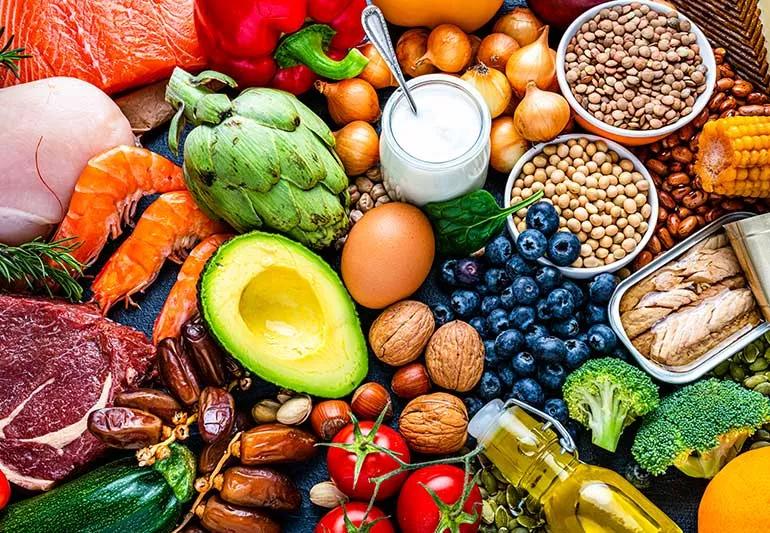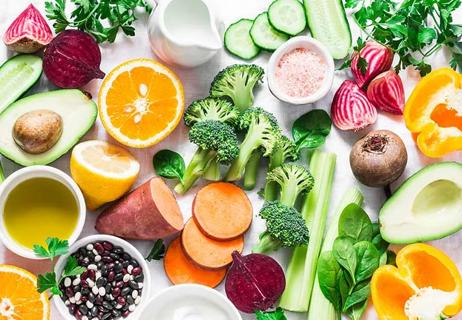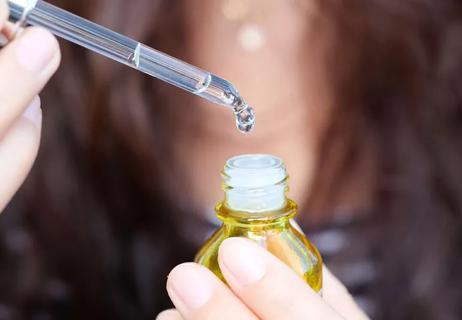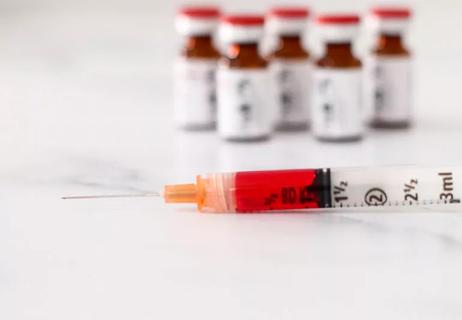Vitamin C and B-complex vitamins pass quickly through your body, so eat them often

Vitamins are compounds that are essential to your body’s functioning. And at the highest level, they get categorized as either being fat-soluble or water-soluble. To keep your body functioning at peak performance, you need both kinds.
Advertisement
Cleveland Clinic is a non-profit academic medical center. Advertising on our site helps support our mission. We do not endorse non-Cleveland Clinic products or services. Policy
The fat-soluble vitamins are A, D, E and K.
Water-soluble vitamins are vitamin C and all the vitamins that start with the letter B (they’re known as the B-complex vitamins or just B vitamins). Water-soluble vitamins are important for your brain function, immune health, energy and more.
Family physician Matthew Goldman, MD, shares more about water-soluble vitamins and how to get the most out of these important nutrients.
There are nine water-soluble vitamins:
Quick aside: Because we know your math brain is wondering where B4, B8, B10 and B11 are, right? Those compounds were at one time considered vitamins. But scientists and physicians now know they’re not really essential for health, so they lost their vitamin status. (Think of them like Pluto of the vitamin world.)
Dr. Goodman shares more about each of these essential nutrients.
Vitamin C is probably one of the most famous out there. You likely already know about its role in your immune system. It’s also a powerful antioxidant. And it helps keep your skin and bones strong and healthy.
Advertisement
How much you should get
The U.S. Food and Drug Administration (FDA) recommends adults and children aged 4 and older get 90 milligrams (mg) of vitamin C each day.
Vitamin C foods
Oranges usually get all the credit for their high vitamin C content, but vitamin C is abundant in a number of fruits and veggies, not just citrus fruits.
| Food | Serving size | Milligrams per serving |
|---|---|---|
| Red pepper | 1/2 cup | 95 |
| Orange juice | 3/4 cup | 93 |
| Orange | 1 medium orange | 70 |
| Grapefruit juice | 3/4 cup | 70 |
| Kiwi | 1 medium kiwi | 64 |
| Green pepper | 1/2 cup | 60 |
| Broccoli (cooked) | 1/2 cup | 60 |
| Strawberries | 1/2 cup | 48 |
| Brussels sprouts | 1/2 cup | 48 |
| Grapefruit | 1/2 medium grapefruit | 39 |
| Food | ||
| Red pepper | ||
| Serving size | ||
| 1/2 cup | ||
| Milligrams per serving | ||
| 95 | ||
| Orange juice | ||
| Serving size | ||
| 3/4 cup | ||
| Milligrams per serving | ||
| 93 | ||
| Orange | ||
| Serving size | ||
| 1 medium orange | ||
| Milligrams per serving | ||
| 70 | ||
| Grapefruit juice | ||
| Serving size | ||
| 3/4 cup | ||
| Milligrams per serving | ||
| 70 | ||
| Kiwi | ||
| Serving size | ||
| 1 medium kiwi | ||
| Milligrams per serving | ||
| 64 | ||
| Green pepper | ||
| Serving size | ||
| 1/2 cup | ||
| Milligrams per serving | ||
| 60 | ||
| Broccoli (cooked) | ||
| Serving size | ||
| 1/2 cup | ||
| Milligrams per serving | ||
| 60 | ||
| Strawberries | ||
| Serving size | ||
| 1/2 cup | ||
| Milligrams per serving | ||
| 48 | ||
| Brussels sprouts | ||
| Serving size | ||
| 1/2 cup | ||
| Milligrams per serving | ||
| 48 | ||
| Grapefruit | ||
| Serving size | ||
| 1/2 medium grapefruit | ||
| Milligrams per serving | ||
| 39 |
Vitamin B1 also goes by the name thiamin or thiamine. It’s important for energy metabolism. It essentially helps turn the food you eat into energy to keep you going.
How much you should get
The FDA recommends adults and children over the age of 4 get 1.2 mg of vitamin B1 each day.
Vitamin B1 foods
Thiamin is found naturally in some animal products and grains. Some packaged foods may be fortified with thiamin as well.
| Food | Serving size | Milligrams per serving |
|---|---|---|
| Thiamin-fortified cereal | 1 serving (per serving size on label) | 1.2 |
| Enriched egg noodles | 1 cup | 0.5 |
| Pork chops | 3 ounces | 0.4 |
| Cooked trout | 3 ounces | 0.4 |
| Black beans | 1/2 cup | 0.4 |
| Enriched English muffin | 1 muffin | 0.3 |
| Cooked bluefin tuna | 3 ounces | 0.2 |
| Whole-wheat macaroni | 1 cup | 0.2 |
| Acorn squash | 1/2 cup | 0.2 |
| Long-grain brown rice | 1/2 cup | 0.2 |
| Food | ||
| Thiamin-fortified cereal | ||
| Serving size | ||
| 1 serving (per serving size on label) | ||
| Milligrams per serving | ||
| 1.2 | ||
| Enriched egg noodles | ||
| Serving size | ||
| 1 cup | ||
| Milligrams per serving | ||
| 0.5 | ||
| Pork chops | ||
| Serving size | ||
| 3 ounces | ||
| Milligrams per serving | ||
| 0.4 | ||
| Cooked trout | ||
| Serving size | ||
| 3 ounces | ||
| Milligrams per serving | ||
| 0.4 | ||
| Black beans | ||
| Serving size | ||
| 1/2 cup | ||
| Milligrams per serving | ||
| 0.4 | ||
| Enriched English muffin | ||
| Serving size | ||
| 1 muffin | ||
| Milligrams per serving | ||
| 0.3 | ||
| Cooked bluefin tuna | ||
| Serving size | ||
| 3 ounces | ||
| Milligrams per serving | ||
| 0.2 | ||
| Whole-wheat macaroni | ||
| Serving size | ||
| 1 cup | ||
| Milligrams per serving | ||
| 0.2 | ||
| Acorn squash | ||
| Serving size | ||
| 1/2 cup | ||
| Milligrams per serving | ||
| 0.2 | ||
| Long-grain brown rice | ||
| Serving size | ||
| 1/2 cup | ||
| Milligrams per serving | ||
| 0.2 |
Vitamin B2 (also called riboflavin) helps keep your blood and blood vessels healthy. That’s because it (along with some other B vitamins) helps regulate your levels of the amino acid homocysteine. Too much homocysteine can lead to blood clots or blood vessel blockages. Vitamin B2 helps turn homocysteine into other chemicals that your body needs.
How much you should get
The FDA recommends adults and children over the age of 4 get 1.3 mg of riboflavin each day.
Vitamin B2 foods
Some foods, particularly animal products, are naturally high in riboflavin. Some red meat, like steak and beef liver, contains high levels of vitamin B2. Eating too much red meat, however, has also been linked to conditions like cancer and heart disease. Aim for no more than one to two servings of red meat per week (6 ounces total per week, at most).
| Food | Serving size | Milligrams per serving |
|---|---|---|
| Beef liver | 3 ounces | 2.9 |
| Fortified breakfast cereals | 1 serving (per serving size on label) | 1.3 |
| Fortified oats | 1 cup | 1.1 |
| Yogurt | 1 cup | 0.6 |
| 2% milk | 1 cup | 0.5 |
| Tenderloin steak | 3 ounces | 0.4 |
| Clams | 3 ounces | 0.4 |
| Dry-roasted almonds | 1 ounce | 0.3 |
| Swiss cheese | 3 ounces | 0.4 |
| Food | ||
| Beef liver | ||
| Serving size | ||
| 3 ounces | ||
| Milligrams per serving | ||
| 2.9 | ||
| Fortified breakfast cereals | ||
| Serving size | ||
| 1 serving (per serving size on label) | ||
| Milligrams per serving | ||
| 1.3 | ||
| Fortified oats | ||
| Serving size | ||
| 1 cup | ||
| Milligrams per serving | ||
| 1.1 | ||
| Yogurt | ||
| Serving size | ||
| 1 cup | ||
| Milligrams per serving | ||
| 0.6 | ||
| 2% milk | ||
| Serving size | ||
| 1 cup | ||
| Milligrams per serving | ||
| 0.5 | ||
| Tenderloin steak | ||
| Serving size | ||
| 3 ounces | ||
| Milligrams per serving | ||
| 0.4 | ||
| Clams | ||
| Serving size | ||
| 3 ounces | ||
| Milligrams per serving | ||
| 0.4 | ||
| Dry-roasted almonds | ||
| Serving size | ||
| 1 ounce | ||
| Milligrams per serving | ||
| 0.3 | ||
| Swiss cheese | ||
| Serving size | ||
| 3 ounces | ||
| Milligrams per serving | ||
| 0.4 |
Vitamin B3 also goes by the name niacin. It helps regulate your cholesterol and blood pressure. It also helps support your brain and skin health.
How much you should get
The FDA recommends adults and children over age 4 get 16 mg of niacin each day.
Vitamin B3 foods
You’ll find high levels of niacin in certain meats, fish, rice and nuts.
| Food | Serving size | Milligrams per serving |
|---|---|---|
| Beef liver | 3 ounces | 14.9 |
| Chicken breast | 3 ounces | 10.3 |
| Spaghetti sauce | 1 cup | 10.3 |
| Turkey breast | 3 ounces | 10 |
| Sockeye salmon | 3 ounces | 8.6 |
| Light tuna (canned) | 3 ounces | 8.6 |
| Pork tenderloin | 3 ounces | 6.3 |
| Ground beef | 3 ounces | 5.8 |
| Brown rice | 1 cup | 5.2 |
| Dry-roasted peanuts | 1 ounce | 4.2 |
| Food | ||
| Beef liver | ||
| Serving size | ||
| 3 ounces | ||
| Milligrams per serving | ||
| 14.9 | ||
| Chicken breast | ||
| Serving size | ||
| 3 ounces | ||
| Milligrams per serving | ||
| 10.3 | ||
| Spaghetti sauce | ||
| Serving size | ||
| 1 cup | ||
| Milligrams per serving | ||
| 10.3 | ||
| Turkey breast | ||
| Serving size | ||
| 3 ounces | ||
| Milligrams per serving | ||
| 10 | ||
| Sockeye salmon | ||
| Serving size | ||
| 3 ounces | ||
| Milligrams per serving | ||
| 8.6 | ||
| Light tuna (canned) | ||
| Serving size | ||
| 3 ounces | ||
| Milligrams per serving | ||
| 8.6 | ||
| Pork tenderloin | ||
| Serving size | ||
| 3 ounces | ||
| Milligrams per serving | ||
| 6.3 | ||
| Ground beef | ||
| Serving size | ||
| 3 ounces | ||
| Milligrams per serving | ||
| 5.8 | ||
| Brown rice | ||
| Serving size | ||
| 1 cup | ||
| Milligrams per serving | ||
| 5.2 | ||
| Dry-roasted peanuts | ||
| Serving size | ||
| 1 ounce | ||
| Milligrams per serving | ||
| 4.2 |
Vitamin B5, also called pantothenic acid, helps make and break down fats.
How much you should get
The FDA recommends 5 mg of vitamin B5 daily for adults and children over the age of 4.
Vitamin B5 foods
The National Institutes of Health says vitamin B5 is present in almost all plant-based and animal-based foods. But certain foods contain higher amounts.
| Food | Serving size | Milligrams per serving |
|---|---|---|
| Beef liver | 3 ounces | 8.3 |
| Fortified breakfast cereal | 1 serving (per serving size on label) | 5 |
| Shitake mushrooms | 1/2 cup | 2.6 |
| Sunflower seeds | 1/4 cup | 2.4 |
| Chicken breast | 3 ounces | 1.3 |
| Fresh bluefin tuna | 3 ounces | 1.2 |
| Avocado | 1/2 avocado | 1 |
| Food | ||
| Beef liver | ||
| Serving size | ||
| 3 ounces | ||
| Milligrams per serving | ||
| 8.3 | ||
| Fortified breakfast cereal | ||
| Serving size | ||
| 1 serving (per serving size on label) | ||
| Milligrams per serving | ||
| 5 | ||
| Shitake mushrooms | ||
| Serving size | ||
| 1/2 cup | ||
| Milligrams per serving | ||
| 2.6 | ||
| Sunflower seeds | ||
| Serving size | ||
| 1/4 cup | ||
| Milligrams per serving | ||
| 2.4 | ||
| Chicken breast | ||
| Serving size | ||
| 3 ounces | ||
| Milligrams per serving | ||
| 1.3 | ||
| Fresh bluefin tuna | ||
| Serving size | ||
| 3 ounces | ||
| Milligrams per serving | ||
| 1.2 | ||
| Avocado | ||
| Serving size | ||
| 1/2 avocado | ||
| Milligrams per serving | ||
| 1 |
Vitamin B6 helps produce red blood cells. It also can protect your heart and even improve your mood.
How much you should get
The FDA recommends adults and children over the age of 4 get 1.7 mg of vitamin B6 each day.
Advertisement
Vitamin B6 foods
Vitamin B6 is commonly associated with animal products, grains vegetables and nuts.
| Food | Serving size | Milligrams per serving |
|---|---|---|
| Chickpeas | 1 cup | 1.1 |
| Beef liver | 3 ounces | 0.9 |
| Fresh yellowfin tuna | 3 ounces | 0.9 |
| Sockeye salmon | 3 ounces | 0.6 |
| Chicken breast | 3 ounces | 0.5 |
| Fortified breakfast cereal | 1 serving (per serving size on label) | 0.4 |
| Potatoes | 1 cup | 0.4 |
| Turkey | 3 ounces | 0.4 |
| Banana | 1 medium banana | 0.4 |
| Spaghetti sauce | 1 cup | 0.4 |
| Food | ||
| Chickpeas | ||
| Serving size | ||
| 1 cup | ||
| Milligrams per serving | ||
| 1.1 | ||
| Beef liver | ||
| Serving size | ||
| 3 ounces | ||
| Milligrams per serving | ||
| 0.9 | ||
| Fresh yellowfin tuna | ||
| Serving size | ||
| 3 ounces | ||
| Milligrams per serving | ||
| 0.9 | ||
| Sockeye salmon | ||
| Serving size | ||
| 3 ounces | ||
| Milligrams per serving | ||
| 0.6 | ||
| Chicken breast | ||
| Serving size | ||
| 3 ounces | ||
| Milligrams per serving | ||
| 0.5 | ||
| Fortified breakfast cereal | ||
| Serving size | ||
| 1 serving (per serving size on label) | ||
| Milligrams per serving | ||
| 0.4 | ||
| Potatoes | ||
| Serving size | ||
| 1 cup | ||
| Milligrams per serving | ||
| 0.4 | ||
| Turkey | ||
| Serving size | ||
| 3 ounces | ||
| Milligrams per serving | ||
| 0.4 | ||
| Banana | ||
| Serving size | ||
| 1 medium banana | ||
| Milligrams per serving | ||
| 0.4 | ||
| Spaghetti sauce | ||
| Serving size | ||
| 1 cup | ||
| Milligrams per serving | ||
| 0.4 |
Biotin is another name for vitamin B7. You may be most familiar with it as an ingredient in some hair, nail and skin care products.
Biotin’s effectiveness in your beauty routine is still up for debate. But we do know that it plays an important role in converting carbohydrates, fats and proteins into energy as part of your diet.
How much you should get
The FDA recommends adults and children age 4 and older get 30 micrograms (mcg) of biotin each day.
Vitamin B7 foods
| Food | Serving size | Micrograms per serving |
|---|---|---|
| Beef liver | 3 ounces | 30.8 |
| Eggs | 1 egg | 10 |
| Canned salmon | 3 ounces | 5 |
| Pork chops | 3 ounces | 3.8 |
| Hamburger patty | 3 ounces | 3.8 |
| Sunflower seeds | 1/4 cup | 2.6 |
| Sweet potato | 1/2 cup | 2.4 |
| Roasted almonds | 1/4 cup | 1.5 |
| Canned tuna | 3 ounces | 0.6 |
| Spinach | 1/2 cup | 0.5 |
| Food | ||
| Beef liver | ||
| Serving size | ||
| 3 ounces | ||
| Micrograms per serving | ||
| 30.8 | ||
| Eggs | ||
| Serving size | ||
| 1 egg | ||
| Micrograms per serving | ||
| 10 | ||
| Canned salmon | ||
| Serving size | ||
| 3 ounces | ||
| Micrograms per serving | ||
| 5 | ||
| Pork chops | ||
| Serving size | ||
| 3 ounces | ||
| Micrograms per serving | ||
| 3.8 | ||
| Hamburger patty | ||
| Serving size | ||
| 3 ounces | ||
| Micrograms per serving | ||
| 3.8 | ||
| Sunflower seeds | ||
| Serving size | ||
| 1/4 cup | ||
| Micrograms per serving | ||
| 2.6 | ||
| Sweet potato | ||
| Serving size | ||
| 1/2 cup | ||
| Micrograms per serving | ||
| 2.4 | ||
| Roasted almonds | ||
| Serving size | ||
| 1/4 cup | ||
| Micrograms per serving | ||
| 1.5 | ||
| Canned tuna | ||
| Serving size | ||
| 3 ounces | ||
| Micrograms per serving | ||
| 0.6 | ||
| Spinach | ||
| Serving size | ||
| 1/2 cup | ||
| Micrograms per serving | ||
| 0.5 |
Vitamin B9 is also called folate. It’s the vitamin most associated with prenatal vitamins. That’s because folate and folic acid are important for healthy fetal development during pregnancy.
But it’s not just for people who are pregnant. Vitamin B9 is also essential for forming red blood cells and DNA.
How much you should get
The FDA recommends adults and children age 4 and older get 400 mcg of folate each day. People who are pregnant are advised to get 600 mcg per day of folate.
Vitamin B9 foods
Unlike other B vitamins, B9 isn’t found in abundance in many foods. That’s why people who are pregnant or trying to conceive are recommended to take supplements to ensure they’re getting adequate amounts.
Advertisement
| Food | Serving size | Micrograms per serving |
|---|---|---|
| Beef liver | 3 ounces | 215 |
| Peanuts | 1/2 cup | 175 |
| Black-eyed peas | 1/2 cup | 105 |
| Fortified breakfast cereals | 1 serving size (per serving size on label) | 100 |
| White rice | 1/2 cup | 90 |
| Asparagus | 4 spears | 89 |
| Enriched pasta | 1/2 cup | 74 |
| Kidney beans | 1/2 cup | 65 |
| Romaine lettuce | 1 cup | 64 |
| Avocado | 1/2 cup | 59 |
| Spinach | 1 cup | 58 |
| Food | ||
| Beef liver | ||
| Serving size | ||
| 3 ounces | ||
| Micrograms per serving | ||
| 215 | ||
| Peanuts | ||
| Serving size | ||
| 1/2 cup | ||
| Micrograms per serving | ||
| 175 | ||
| Black-eyed peas | ||
| Serving size | ||
| 1/2 cup | ||
| Micrograms per serving | ||
| 105 | ||
| Fortified breakfast cereals | ||
| Serving size | ||
| 1 serving size (per serving size on label) | ||
| Micrograms per serving | ||
| 100 | ||
| White rice | ||
| Serving size | ||
| 1/2 cup | ||
| Micrograms per serving | ||
| 90 | ||
| Asparagus | ||
| Serving size | ||
| 4 spears | ||
| Micrograms per serving | ||
| 89 | ||
| Enriched pasta | ||
| Serving size | ||
| 1/2 cup | ||
| Micrograms per serving | ||
| 74 | ||
| Kidney beans | ||
| Serving size | ||
| 1/2 cup | ||
| Micrograms per serving | ||
| 65 | ||
| Romaine lettuce | ||
| Serving size | ||
| 1 cup | ||
| Micrograms per serving | ||
| 64 | ||
| Avocado | ||
| Serving size | ||
| 1/2 cup | ||
| Micrograms per serving | ||
| 59 | ||
| Spinach | ||
| Serving size | ||
| 1 cup | ||
| Micrograms per serving | ||
| 58 |
Vitamin B12 helps produce red blood cells, supports healthy brain function, gives you an energy boost and may even help keep your vision strong.
How much you should get
The FDA recommends adults and children age 4 and older get 2.4 mcg of vitamin B12 per day.
Vitamin B12 foods
| Food | Serving size | Micrograms per serving |
|---|---|---|
| Beef liver | 3 ounces | 70.7 |
| Clams | 3 ounces | 17 |
| Fortified nutritional yeast | 1 serving (per serving size on label) | 8.3 to 24 (depending on brand) |
| Atlantic Salmon | 3 ounces | 2.6 |
| Light canned tuna | 3 ounces | 2.5 |
| Ground beef | 3 ounces | 2.4 |
| 2% milk | 1 cup | 1.3 |
| Yogurt | 6 ounces | 1 |
| Fortified breakfast cereal | 1 serving (per serving size on label) | 0.6 |
| Cheddar cheese | 1 1/2 ounces | 0.5 |
| Eggs | 1 large egg | 0.5 |
| Food | ||
| Beef liver | ||
| Serving size | ||
| 3 ounces | ||
| Micrograms per serving | ||
| 70.7 | ||
| Clams | ||
| Serving size | ||
| 3 ounces | ||
| Micrograms per serving | ||
| 17 | ||
| Fortified nutritional yeast | ||
| Serving size | ||
| 1 serving (per serving size on label) | ||
| Micrograms per serving | ||
| 8.3 to 24 (depending on brand) | ||
| Atlantic Salmon | ||
| Serving size | ||
| 3 ounces | ||
| Micrograms per serving | ||
| 2.6 | ||
| Light canned tuna | ||
| Serving size | ||
| 3 ounces | ||
| Micrograms per serving | ||
| 2.5 | ||
| Ground beef | ||
| Serving size | ||
| 3 ounces | ||
| Micrograms per serving | ||
| 2.4 | ||
| 2% milk | ||
| Serving size | ||
| 1 cup | ||
| Micrograms per serving | ||
| 1.3 | ||
| Yogurt | ||
| Serving size | ||
| 6 ounces | ||
| Micrograms per serving | ||
| 1 | ||
| Fortified breakfast cereal | ||
| Serving size | ||
| 1 serving (per serving size on label) | ||
| Micrograms per serving | ||
| 0.6 | ||
| Cheddar cheese | ||
| Serving size | ||
| 1 1/2 ounces | ||
| Micrograms per serving | ||
| 0.5 | ||
| Eggs | ||
| Serving size | ||
| 1 large egg | ||
| Micrograms per serving | ||
| 0.5 |
Water-soluble vitamins dissolve in water. That means the water in your body absorbs these vitamins to put them to use.
Unlike fat-soluble vitamins, water-soluble vitamins don’t get stored in your body for long.
“Water-soluble vitamins move through your system quickly,” Dr. Goodman explains. “So, they need to be replenished frequently.”
That means it’s important to eat plenty of foods containing vitamins C and all the Bs regularly. That helps make sure you have enough of them circulating in your system.
And because they don’t stick around for long, it’s rare to have too much vitamin C or any of the B-complex vitamins in your system. What doesn’t get used just gets passed through your kidneys and leaves your body through your urine.
The best advice is to take a food-first approach to getting the nutrients your body needs, rather than relying on supplements. Whole foods have so many compounds that your body uses to keep healthy that supplements just can’t replicate as effectively.
Advertisement
But if you choose to take a supplement to ensure you’re getting enough vitamin C or B-complex vitamins, it’s safe for most people to do so, Dr. Goodman says.
That’s because, for most people, your body will rid itself of extra water-soluble vitamins. So, if you’re also getting vitamins from the food in your diet, supplements may mean you’re peeing out much of what you’re taking in. (Money literally down the toilet.)
If you’re concerned that you’re not getting enough water-soluble vitamins in your diet, talk with a healthcare professional, like a primary care doctor or a dietitian, about your intake and their advice.
Learn more about our editorial process.
Advertisement

Move over, oranges! You can also get vitamin C from strawberries, kiwi and green veggies

From healing wounds to boosting your immune system, this is one multifaceted vitamin

Not only can it strengthen your immune system, but vitamin C can do a whole lot more, too

This popular ingredient isn’t just for citrus fruits anymore

Eat your fill of vitamins C, B6 and E, plus zinc and selenium

Instead of relying on supplements, choose foods that boost your immune system

There are several vitamins and mineral supplements that many people can benefit from — but it’s important to consult with a healthcare provider before you start one

If you have low B12 or a true deficiency, these shots can work wonders

Type 2 diabetes isn’t inevitable with these dietary changes

Applying a hot or cold compress can help with pain